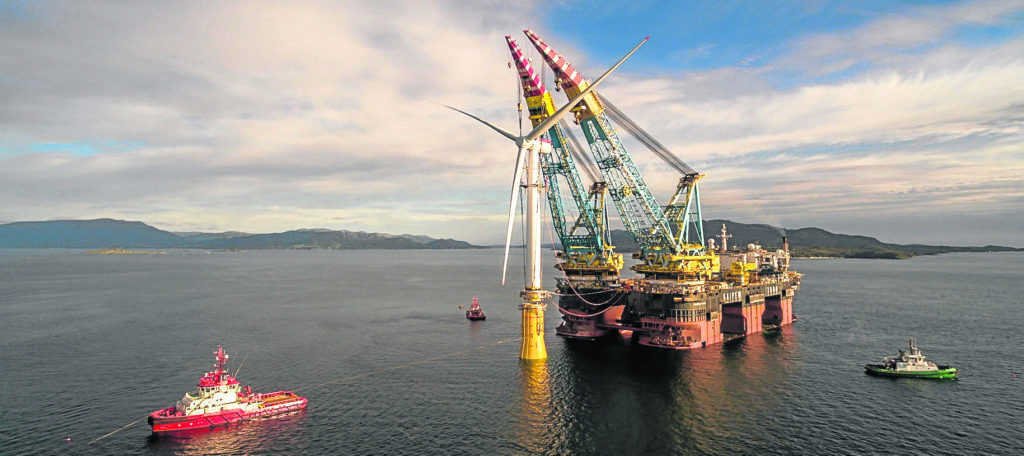
“You can see that we’re serious about this, can’t you?” said Vince McCarthy, Saipem’s chief operating officer, as we ate lunch aboard the company’s semi-submersible crane vessel moored in Cartagena, Spain.
Looking at me seriously, McCarthy’s talking about Saipem’s ambitious plans to transition from oil and gas construction work into the offshore wind energy marketplace.
While he’d hinted at the company’s plans the previous evening, now – post presentation – he knows Saipem has been clear about its desire to move into the UK continental shelf offering end-to-end project windfarm delivery.
Traditionally known as an oil and gas construction company, the Italian firm recently welcomed 70 offshore wind developers aboard the Saipem 7000 vessel to showcase its plans, which also include designing its own floating turbine.
Saipem believes it can add value to the burgeoning offshore wind sector, even lifting a huge turbine blade hundreds of metres into the air to prove its point.
With a deck about the size of two football pitches and two imposing cranes easily eclipsing Big Ben, Saipem 7000 is a huge, muscular crane rig capable of lifting 7,000 tonnes.
It is a hive of activity with busy workers coming and going between decks – the ever-present hiss and clunk of heavy moving metal impossible to ignore.
As I crawl into my single bunk for the night I quickly get a sense of the world as it must be for an offshore worker; a dangerous, loud and claustrophobic existence, but one which offers a hard to find sense of independence.
Last year, Saipem 7000 facilitated the Statoil Hywind project by lifting the turbines and towers and installing them on floating foundations at a yard in Norway, before their transportation to Scottish waters.
Building on the success of that relationship, Saipem is in continued discussions with those at the helm of Statoil – soon to be Equinor – about future UK offshore wind developments, including the proposed Dogger Bank project off the coast of Yorkshire.
“One of the things that sets Statoil apart from others is that they are not afraid of innovation,” Mr McCarthy said.
“They’re not afraid to come up with solutions that are different. That’s also where we come from; our DNA is also based in that. They think in the same way we do.
“Statoil knows Saipem can do the engineering, procurement and construction work that they’ve already used us for.”
In order to meaningfully achieve its transition into a new marketplace, Saipem has ploughed £55million into technological innovation with a further £64million going into commercial and investment projects, like its offshore fleet.
The investment is already paying off, with the Saipem 7000 posted to Orsted’s Hornsea One Project off north-east England. On site and due to begin work any day, the vessel first went to
Rotterdam for mobilisation before heading to the development.
During the morning presentation, Paolo Formica, Saipem offshore area manager for the North Sea, confirmed that this was part of his firm’s “growing presence in the UK” and that in the next few years most of its work “will be concentrated in the UK continental shelf.”
Furthering that aim, Saipem bosses said they were also in discussion with the companies behind the Inch Cape project off the coast of Angus and the Mainstream Renewable Power run Neart Na Gaoithe (NnG) development with a view to providing services.
Coming off the success of the Hywind installation, Saipem is also looking at a concept design for a floating turbine to rival what’s already being tested in the field.
With contracts for difference rounds coming thick and fast in the offshore wind sector, the company’s undertakings must meet its ambition, especially in terms of technological innovation given the pace of change within the industry.
Mr McCarthy is only too aware of how quickly the industry is looking at larger, more powerful and efficient turbines at deep water, all coming at a deliverable cost to developers.
“After the Hywind project we have to consider 15megawatt turbines,” Mr McCarthy said.
“We also have to provide a model that gives a keen and agile operation and it has to be cost driven. If it doesn’t have a value then we don’t do it. We have to shave all cost from the process [to compete.”
Saipem is in this thing for the long haul.
With its strong 60-year history of working in offshore construction, Mr McCarthy is keen to stress that Saipem understands the requirements and the route to a successful and cost effective windfarm development from the engineering point of view, through procurement, construction and transportation to installation and the resulting lifecycle of the project.
“Obviously we want to be involved from beginning to end,” Mr McCarthy said. “But we are able to come in at any stage of the development. We have to project quality every time. We believe our ability in production will be the difference in the energy sector.”
Mr Formica views Saipem’s involvement in this new venture in the same way and sees the company’s past experience of providing offshore developments with a full service at a “western standard” as important to the market.
He said: “The more we work across the chain, the more value we can add. We can deliver better projects. We need to be flexible in the core of our business proposition because we want to be unique.”
With discussions going on across the sector and development ramping up at a pace that’s hard to comprehend at times, Saipem will have to be agile while also proving it can do the job and adapt with each contract win.
One thing they don’t lack is confidence. “We are able to put development projects in a better competitive position,” Mr Formica said. “We want developers to see us as an operation partner rather than a contractor for hire.”
Recommended for you
